9 Best Trolling Lures For Great Lakes Salmon
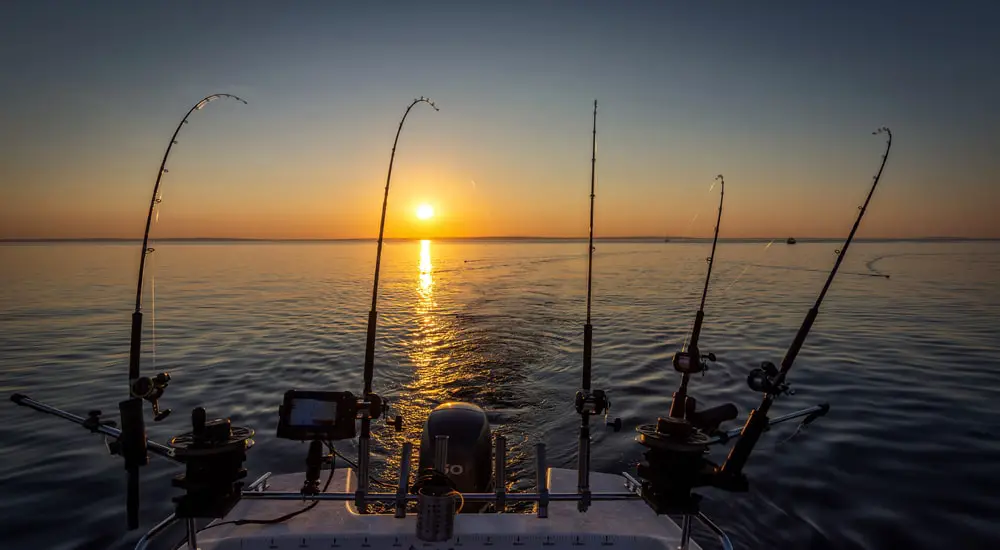
Great Lakes salmon fishing is a thrilling endeavor for anglers seeking to reel in trophy fish you need to be using the best trolling lures for Great Lakes salmon if you want to be successful.
With an abundance of king salmon, coho salmon, steelhead, lake trout, and even some Atlantic salmon, the Great Lakes offer incredible opportunities for anglers.
I’ll reveal the most effective Great Lakes salmon trolling lures that the salmon charters use.
I’ll also get into some tips and tricks for each lure, as well as discuss some other great fishing tips for trolling for salmon.
Top Eight Salmon Lures For Trolling Great Lakes Salmon
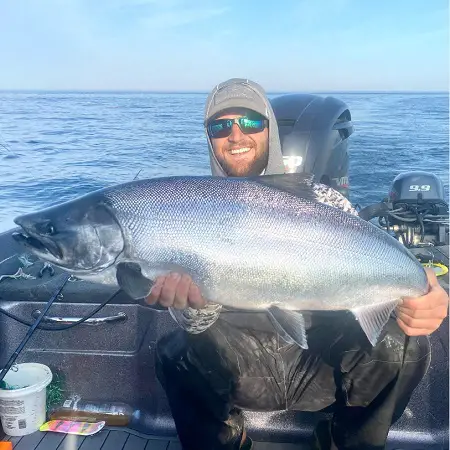
These trolling lures for Great Lakes salmon are not in any particular order since conditions change, and therefore, so does the best lure.
In general, for trolling, most charter boats are running spoons like Dreamweaver and Michigan Stingers, Trolling Flies, and Cutbaits. See Best Trolling Spoons For Salmon.
1. Orange J-9 Jointed Rapala for Coho Salmon
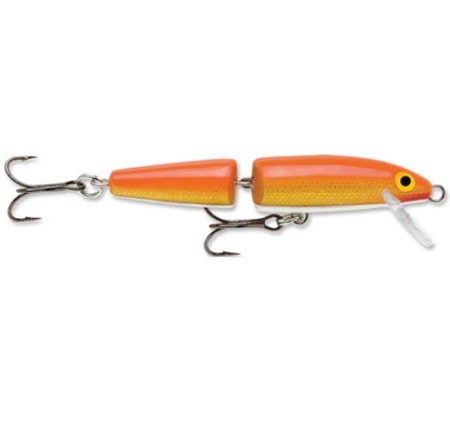
The J-9 Rapala is recommended by many anglers and even some well-known guides as one of the best lures for Great Lakes coho salmon. The orange is actually called the Gold Fluorescent Red now.
It has won the trust of many anglers due to its remarkable effectiveness for coho salmon and steelhead.
It works best when the line is set quite far from the boat, ideally between 250 and 400 feet. It often beats other crankbaits and spoons, especially when run near the surface using planer boards in the spring and fall.
Its effectiveness is proven in all the Great Lakes and is also great for catching steelhead in Lake Erie.
2. Little Cleo Spoons
A Small but mighty lure is the Acme Little Cleo Spoon which might be famous among fishermen for its compact design and strong performance in catching salmon and steelhead from shore and when trolling.
They are used to troll near the surface in the spring and fall when the salmon are closer to the surface.
These spoons don’t need additional downriggers or divers, but can also work well with them.
They come in various colors, with the Purple-Black, Blue-Green, and Gold Fluorescent Stripe, and Orange versions being the most popular among anglers.
The Little Cleo is also on my list of the best lures for salmon fishing in rivers.
3. KO Wobbler Spoon
A Different Approach The KO Wobbler, while not as commonly used as the Little Cleo, can bring a unique element to the fishing game. It has a different movement and vibration that can attract curious salmon.
It can also go deeper than other spoons, which can be beneficial for reaching fish that are further down, which makes it a good option as a Great Lakes salmon trolling lure.
4. Michigan Stinger Spoons:
The Michigan Stinger Stingray spoons are lightweight and glow in the dark, which makes them attractive to fish, and these are very popular trolling lures for Great Lakes salmon charter boats and experienced anglers. I used to sell a lot of these to the competition salmon anglers fishing in Lake Ontario, Lake Huron, and Georgian Bay.
They are designed for slower trolling speeds and work best when set deep. They have proven their effectiveness, especially with the Glo Alewife and Natural Born Killer color options.
5. Blue Coyote Spoon
Adaptable and Reliable, The Blue Coyote spoon is a versatile option that’s favored by West Coast anglers for ocean salmon fishing, but it’s becoming more known as a good Great Lakes salmon trolling lure.
It’s useful in the Great Lakes for catching coho and king salmon.
It’s a lightweight spoon that can be trolled at slower speeds and is great for anglers who like a slower, more controlled pace.
6. Dreamweaver and Northern King Spoons:
When it comes to trolling lures for Great Lakes salmon, these two spoons may be responsible for catching more salmon than any other lure.
These spoons are highly successful for catching salmon which is why they were a top seller in my fishing store.
They come in many sizes and colors. When fishing at a pace of around three mph, these spoons work best. They’re particularly effective when used on downriggers, Dipsy Divers, or jet divers.
Orange Dreamweaver spoons have been particularly successful for coho salmon and steelhead, but there are so many colors to choose from.
7. Pro-Troll Flasher with Fly
I remember the first time I’d hear about flashers and flies, and thought, really, do these actually work? Well, yes they do, and they are now popular because they work very well.
When it comes to trolling flies, anglers new to salmon fishing would not consider them actual lures for Great Lakes salmon, but a combo of a flasher and a following trolling fly can be irresistible for king salmon.
The flasher creates a rolling motion that simulates a feeding frenzy, attracting nearby fish. Green flashers paired with ultraviolet or green flies are favorites.
For those new to this, it might be a good idea to buy a leader and fly combo.
8. Flasher and Hoochie
When discussing the trolling lures for Great Lakes salmon need to include this power pair.
The combination of a flasher with a hoochie has been a successful method for attracting salmon for many years now.
Hotspot flashers in colors like green haze UV and chrome-mylar have proven effective, especially when paired with the Boone ultra-violet green haze hoochie. This setup has been recognized as one of the best for the Great Lakes.
9. Cut-Baits
When it comes to unique lures for Great Lakes salmon trolling, the cut bait is a versatile bait for fishing salmon.
It is available as pre-cut herring strips, whole herrings, smelt, or alewives.
Cut-Bait Heads are specialized tools that securely hold the bait and aid smooth movement underwater. They can be assembled or purchased pre-rigged.
To rig a cut-head, use heavy mono line and reliable treble hooks, aligning them with the bait properly.
Teaser or Twinkie rigs with attractors can be used alongside the cut head to attract fish. Cut-bait is effective in catching kings, Lakers, and steelhead. While best during mid-summer to late fall, it can be used as early as mid-April.
Salmon Trolling Techniques for the Great Lakes: Downriggers and Planer Boards
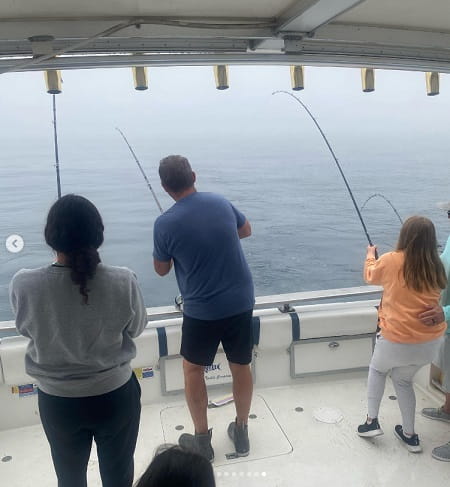
When it comes to trolling for salmon in the vast waters of the Great Lakes, using downriggers and planer boards is essential for a successful fishing expedition, especially in the summer when the salmon are deep.
These tools provide anglers with precise depth control and expand the fishing area, increasing the chances of enticing salmon to strike.
Planner Boards To Maximize Coverage
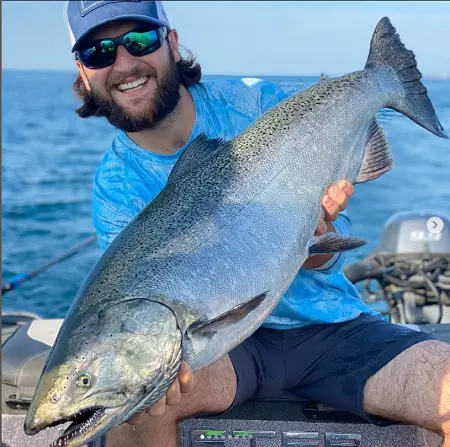
Planer boards are attached to the boat using ropes and are designed to carry fishing lines away from the boat, similar to outriggers on larger offshore fishing vessels.
In fact, planer boards are even more effective than outriggers in extending the distance of the lines from the boat.
To secure planer boards, a rope is connected to the boat with a planner reel, and the fishing line is attached to the rope using release clips that can slide down the line.
The advantage of planer boards is that they allow for one or two lines to be positioned far out to the sides of the boat. This is particularly beneficial when targeting steelhead and coho salmon, as these species tend to stay in shallower waters during the fall salmon season.
By setting lines to the side, the boat’s presence is less likely to spook the fish, and any disturbances caused by the boat will push the fish toward the planer board lines.
Investing in quality plastic planer boards of appropriate size is crucial for maintaining stability and performance, even in wavy conditions.
Each planer board should be connected to an elevated reel with a durable 200-pound braided line or rope. Fishing rods are then set at the desired distance behind the boat and attached to clips that slide down the planer line as more line is released from the fishing pole.
Depending on the size of the boat and the number of anglers on board, I will run one, two, or three rods on each side to significantly increase the fishing coverage resulting in more salmon.
It is common to set lines 100 to 300 feet to the side of the boat to maximize the chances of attracting salmon.
Inline planner boards that go on the actual fishing line are another cheaper but still good option, especially in spring and fall when the salmon are closer to shore.
Use Downriggers To Get The Lures In The Right Spot
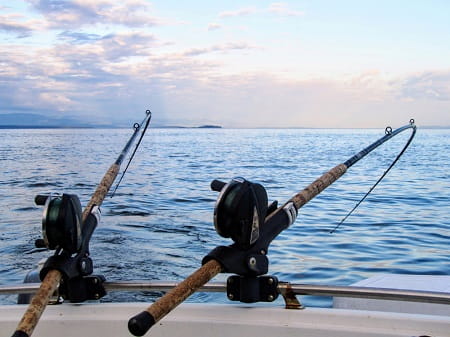
Downriggers, on the other hand, are indispensable tools for salmon fishing in the Great Lakes, especially during the summer when the salmon are very deep.
Without them, I probably could not catch salmon at times.
Downriggers provide precise depth control, allowing anglers to target specific depths where salmon are known to congregate.
King salmon and lake trout, in particular, are frequently found below 60 feet and are commonly caught in the 60 to 200-foot range. Downriggers eliminate the guesswork by providing a line counter that displays the depth of the downrigger ball.
This information can also be observed on the fish finder when trolling at slow speeds or when the ball is set shallow.
To optimize the chances of enticing a bite, the depth of the downrigger ball should be adjusted to position the bait 3 to 15 feet above the fish. It’s important to consider the blowback of the line, which affects the actual depth of the bait.
Typically, the depth indicated on the line counter is around 90 percent of the actual depth.
When utilizing downriggers, spoons, plugs, or flasher and fly setups are commonly placed a few feet behind the ball to increase visibility and attract the attention of salmon.
Downriggers can run from just over $100 for a manual downrigger to over $2000.00 for electric high-end downriggers.
Running Multiple Lines and Lures For More Success
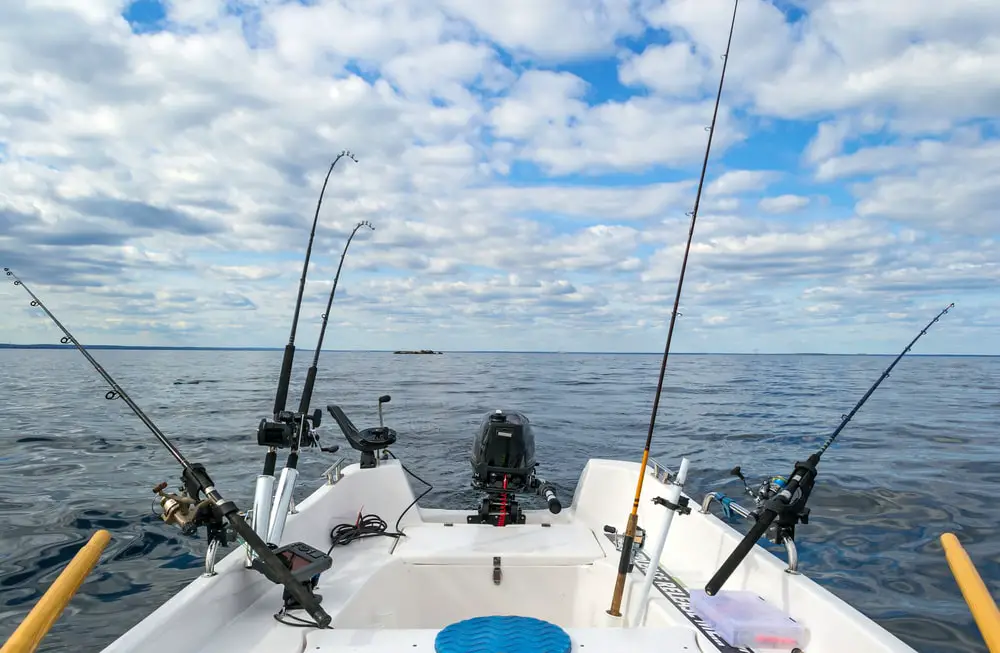
Having multiple lines set at different depths is vital for successful salmon fishing in the Great Lakes. Salmon species, such as coho and steelhead, tend to stay higher in the water column and nearer to the surface, while king salmon and lake trout prefer deeper waters.
By deploying a combination of downriggers, planer boards, dipsey divers, jet divers, and lead core lines, anglers can cover a wider range of depths and increase their chances of encountering active fish.
Adjusting the trolling speed and the amount of line deployed will determine the specific depth at which the bait is presented.
Using Cut Baits For Great Lakes Salmon
Different methods can be employed to utilize Cut-bait effectively in fishing.
Let’s start by understanding what cut bait is. Cut-bait refers to various types of bait that are cut into strips or used as a whole. The most popular choice is pre-cut herring strips, which are readily available in frozen form at bait and tackle shops near the Great Lakes. Other options include whole herrings, smelt, and alewives.
Several manufacturers offer a specialized tool called a Cut-Bait Head. Examples include Rhys Davis, John King, Church Tackle, and Challenger Lures. These heads serve the purpose of securing the cut-bait strip or whole herring and ensuring smooth movement through the water when using the cut rig.
One can either purchase just the cut-heads and assemble them independently or opt for pre-rigged versions that come with hooks or a triple rig setup.
When rigging a cut-head, it is advisable to utilize a heavy mono line, preferably around 50lb. The stiffness of the mono line adds action to the cut-head when it is used behind a flasher.
As for the hooks, any reliable treble hook can be used, such as those commonly used for J-plugs. Adjust the hook position to align with the back tip of the cut strip or the tail of the whole herring.
Alternatively, one can purchase pre-rigged cut heads, complete with hooks and lines. Another option is the Teaser rig or Twinkie rig, which involves attaching 1 to 3 fly or squid-type attractors on a leader placed ahead of the cut head.
For running a straight-cut head, it is recommended to position it around 12 to 14 inches behind a flasher. This setup can be attached to a dipsy diver or connected directly to downrigger balls, positioned approximately 8 to 15 feet behind the ball.
A 4-foot leader behind a dipsy can also be utilized. The ideal depth range for this setup will be dependent on the depth at which the salmon are feeding.
Using cut bait can be highly effective for catching kings, Lakers, and even steelhead. While mid-summer to late fall is typically the best time for using cut bait, starting as early as mid-April is not uncommon.
Guide Tip: If you really want to learn how to do this, nothing beats seeing it done firsthand by a pro. Hire a charter boat service for the day, and they will show you how it’s done right.
Conclusion: Trolling Lures For Great Lakes Salmon
Salmon fishing in the Great Lakes offers an unparalleled experience for anglers seeking trophy fish and unforgettable memories.
By utilizing the proven trolling lures known to catch Great Lakes salmon consistently, such as Dreamweaver and Northern King spoons, Pro-Troll flasher with fly setups, Orange J-9 Jointed Rapala, Little Cleo spoons, and a variety of other effective options, anglers can significantly increase their chances of success.
Understanding the behavior and preferences of different salmon species is key to selecting the right lures and fishing techniques.
King salmon, coho salmon, steelhead, and lake trout each have their unique characteristics and habitat preferences within the Great Lakes. By studying their feeding patterns and seasonal movements, anglers can make informed decisions when it comes to lure selection and presentation.
Additionally, utilizing trolling techniques with the aid of downriggers and planer boards allows for precise depth control and expands the fishing area, increasing the chances of attracting and hooking salmon.
Whether I am targeting salmon in the open waters of Lake Michigan, Lake Ontario, Lake Huron, or Lake Superior, or exploring the rivers and streams connected to these lakes, adapting my tactics to the specific conditions and employing the right lures will greatly enhance my fishing experience.
Remember to always comply with local fishing regulations, including size and bag limits, and practice responsible catch-and-release methods to preserve the salmon populations in the Great Lakes for future generations.
Tight Lines,
Graham

Thanks for the article!
Is it supposed to be “Original” not “orange” when describing the Rapala J9? They do not seem to have an orange color. Thanks, DC
Hey Doug,
It is the Orange color that is the hot color, it’s actually called the Gold Fluorescent Red so i just updated that. thanks for pointing that out. . You can get it at FishUSA.com
Good luck
Graham